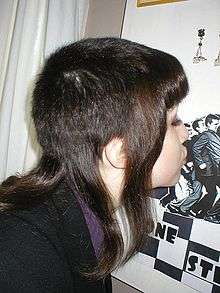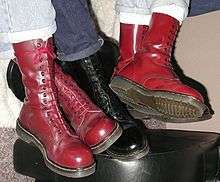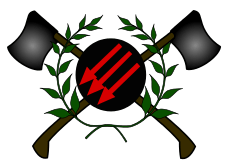Skinhead

A skinhead is a member of a subculture originating among working class youths in London, England in the 1960s that soon spread to other parts of the United Kingdom, with a second working class skinhead movement spreading worldwide in the 1980s. Motivated by social alienation and working class solidarity, skins are defined by their close-cropped or shaven heads and working class clothing such as Dr. Martens boots, braces (known as suspenders in American English), high-ankle straightleg jeans, and smart shirts. The movement began in the late 1960s and reached a peak during an early-1980s revival.
Skinheads came in two waves; in the late 1960s and early 1980s. The first skins were working class youth motivated by an expression of alternative values, rejecting both 1950s austerity and conservatism and the more middle class or bourgeois 1960s peace and love ethos and hippie movement. Skinheads were instead drawn towards more working class outsider cultures, incorporating elements of mod fashion and black music and fashion, especially from Jamaican rude boys.[1] The second wave were often ex-punks. Both first and second generation skins were influenced by the heavy, repetitive rhythms of dub, as well as ska, rocksteady, reggae, and African-American soul music. 1980s skins were closely aligned with anarchists and anarcho-punks, first wave punk, Oi! and street punk, ska, 2 Tone ska, ska punk, dub, and hardcore punk. Contemporary skinhead fashions ranges from clean-cut 1960s mod-influenced styles to less-strict punk- and hardcore-influenced styles.[2]
During the early 1980s, political affiliations grew in significance and split the subculture, distancing the far right and far left strands, although many skins describe themselves as apolitical. As a movement that was highly regionalised and excluded by society's moral norms, skinhead culture sometimes attracted some right-wing elements and was eventually tainted in the mid 1980s by tabloid hysteria of a fringe and violent far-right elements representing extreme nationalism.[3] According to Shane Meadows, "It's unfortunate that the racist elements have become such a by-word for skinhead culture. The media has played its part in this, but by the same token it's clear the fascist element has always been fairly vocal in skinhead culture. The sad bit is that the more enlightened, anti-fascist aspects have not better promoted themselves."[4] Since the 1990s, the style has been adopted by disaffected, Neo-Nazi youths in the former East Germany, Finland, central European countries, and Russia.
History

Origins and first wave
In the late 1950s the post-war economic boom led to an increase in disposable income among many young people. Some of those youths spent that income on new fashions popularised by American soul groups, British R&B bands, certain film actors, and Carnaby Street clothing merchants.[5][6] These youths became known as mods, a youth subculture noted for its consumerism and devotion to fashion, music and scooters.[7]
Working class mods utilised practical clothing styles that suited their lifestyle and employment circumstances: work boots or army boots, straight-leg jeans or Sta-Prest trousers, button-down shirts and braces. When possible, these working class mods spent their money on suits and other sharp outfits to wear at dancehalls, where they enjoyed soul, ska, bluebeat and rocksteady music.[1][8]
Around 1966, a schism developed between the peacock mods (also known as smooth mods), who were less violent and always wore the latest expensive clothes, and the hard mods (also known as gang mods, lemonheads or peanuts), who were identified by their shorter hair and more working class image.[9] Hardcore mods became commonly known as skinheads by about 1968.[10] Their short hair may have come about for practical reasons, since long hair could be a liability in industrial jobs and streetfights. Skinheads may also have cut their hair short in defiance of the more middle class hippie culture.[11]
In addition to retaining many mod influences, early skinheads were very interested in Jamaican rude boy styles and culture, especially the music: ska, rocksteady, and early reggae (before the tempo slowed down and lyrics became focused on topics like black nationalism and the Rastafari movement).[1][12][13]
Skinhead culture became so popular by 1969 that even the rock band Slade temporarily adopted the look as a marketing strategy.[14][15][16] The subculture gained wider notice because of a series of violent and sexually explicit novels by Richard Allen, notably Skinhead and Skinhead Escapes.[17][18] Due to largescale British migration to Perth, Western Australia, many British youths in that city joined skinhead/sharpies gangs in the late 1960s and developed their own Australian style.[19][20]

By the early 1970s, the skinhead subculture started to fade from popular culture, and some of the original skins dropped into new categories, such as the suedeheads (defined by the ability to manipulate one's hair with a comb), smoothies (often with shoulder-length hairstyles), and bootboys (with mod-length hair; associated with gangs and football hooliganism).[10][11][21][22] Some fashion trends returned to the mod roots, with brogues, loafers, suits, and the slacks-and-sweater look making a comeback.
Second wave
In the late 1970s, the skinhead subculture was revived to a notable extent after the introduction of punk rock. Most of these revivalist skinheads reacted to the commercialism of punk by adopting a look that was in line with the original 1969 skinhead style. This revival included Gary Hodges and Hoxton Tom McCourt (both later of the band the 4-Skins) and Suggs, later of the band Madness. Around this time, some skinheads became affiliated with far right groups such as the National Front and the British Movement.[23] From 1979 onwards, punk-influenced skinheads with shorter hair, higher boots and less emphasis on traditional styles grew in numbers and grabbed media attention, mostly due to football hooliganism. There still remained, however, skinheads who preferred the original mod-inspired styles.[24]
Eventually different interpretations of the skinhead subculture expanded beyond Britain and continental Europe. In the United States, certain segments of the hardcore punk scene embraced skinhead styles and developed their own version of the subculture.[25]
Style
Hair
Most first wave skinheads wore No. 2 or No. 3 grade clip guard cuts (short, but not bald). From the late 1970s, male skinheads typically shaved their heads with a No. 2 grade clip or shorter. During that period, side partings were sometimes shaved into the hair. Since the 1980s, some skinheads have clipped their hair with no guard, or even shaved it with a razor. Some skinheads sport sideburns of various styles, usually neatly trimmed, but most skinheads do not have mustaches or beards.
By the 1970s, most female skins had mod-style haircuts. During the 1980s skinhead revival, many female skinheads had feathercuts (Chelsea in North America). A feathercut is short on the crown, with fringes at the front, back and sides. Some female skinheads have a shorter punk-style version of the hairstyle, called a Chelsea cut, which is almost entirely shaved, leaving only bangs and fringes at the front.
Clothing

Skinheads wear long-sleeve or short-sleeve button-up shirts or polo shirts by brands such as Ben Sherman, Fred Perry, Brutus, Warrior or Jaytex; Lonsdale or Everlast shirts or sweatshirts; Grandfather shirts; V-neck sweaters; sleeveless sweaters; cardigan sweaters or T-shirts (plain or with text or designs related to the skinhead subculture). They may wear fitted blazers, Harrington jackets, bomber jackets, denim jackets (usually blue, sometimes splattered with bleach), donkey jackets, Crombie-style overcoats, sheepskin ¾-length coats, short macs, monkey jackets or parkas. Traditional skinheads sometimes wear suits, often of two-tone tonic fabric (shiny mohair-like material that changes colour in different light and angles), or in a Prince of Wales or houndstooth check pattern.
Many skinheads wear Sta-Prest flat-fronted slacks or other dress trousers; jeans (normally Levi's, Lee or Wrangler); or combat trousers (plain or camouflage). Jeans and slacks are worn deliberately short (either hemmed, rolled or tucked) to show off boots, or to show off socks when wearing loafers or brogues. Jeans are often blue, with a parallel leg design, hemmed or with clean and thin rolled cuffs (turn-ups), and are sometimes splattered with bleach to resemble camouflage trousers (a style popular among Oi! skinheads).
Many traditionalist skinheads wear braces, in various colours, usually no more than 1" in width, clipped to the trouser waistband. In some areas, braces much wider than that may identify a skinhead as either unfashionable or as a white power skinhead. Traditionally, braces are worn up in an X shape at the back, but some Oi!-oriented skinheads wear their braces hanging down. Patterned braces — often black and white check, or vertical stripes — are sometimes worn by traditional skinheads. In a few cases, the colour of braces or flight jackets have been used to signify affiliations. The particular colours chosen have varied regionally, and have had totally different meanings in different areas and time periods. Only skinheads from the same area and time period are likely to interpret the colour significations accurately. The practice of using the colour clothing items to indicate affiliations has become less common, particularly among traditionalist skinheads, who are more likely to choose their colours simply for fashion.
Hats common among skinheads include: Trilby hats; pork pie hats; flat caps (Scally caps or driver caps), winter woollen hats (without a bobble). Less common have been bowler hats (mostly among suedeheads and those influenced by the film A Clockwork Orange).
Traditionalist skinheads sometimes wear a silk handkerchief in the breast pocket of a Crombie-style overcoat or tonic suit jacket, in some cases fastened with an ornate stud. Some wear pocket flashes instead. These are pieces of silk in contrasting colours, mounted on a piece of cardboard and designed to look like an elaborately folded handkerchief. It was common to choose the colours based on one's favourite football club. Some skinheads wear button badges or sewn-on fabric patches with designs related to affiliations, interests or beliefs. Also popular are woollen or printed rayon scarves in football club colours, worn knotted at the neck, wrist, or hanging from a belt loop at the waist. Silk or faux-silk scarves (especially Tootal brand) with paisley patterns are also sometimes worn. Some suedeheads carried closed umbrellas with sharpened tips, or a handle with a pull-out blade. This led to the nickname brollie boys.

Female skinheads generally wear the same clothing items as men, with addition of skirts, stockings, or dress suits composed of a ¾-length jacket and matching short skirt. Some skingirls wear fishnet stockings and mini-skirts, a style introduced during the punk-influenced skinhead revival.
Footwear

Most skinheads wear boots; in the 1960s army surplus or generic workboots, later Dr. Martens boots and shoes. In 1960s Britain, steel-toe boots worn by skinheads and hooligans were called bovver boots; whence skinheads have themselves sometimes been called bovver boys. Skinheads have also been known to wear brogues, loafers or Dr. Martens (or similarly styled) low shoes.
In recent years, other brands of boots, such as Solovair, Tredair and Grinders, have become popular among skinheads, partly because most Dr. Martens are no longer made in England. Football-style athletic shoes, by brands such as Adidas or Gola, have become popular with many skinheads. Female or child skinheads generally wear the same footwear as men, with the addition of monkey boots. The traditional brand for monkey boots was Grafters, but nowadays they are also made by Dr. Martens and Solovair.
In the early days of the skinhead subculture, some skinheads chose boot lace colours based on the football team they supported. Later, some skinheads (particularly highly political ones) began to use lace colour to indicate beliefs or affiliations. The particular colours chosen have varied regionally, and have had totally different meanings in different areas and time periods. Only skinheads from the same area and time period are likely to interpret the colour significations accurately. This practice has become less common, particularly among traditionalist skinheads, who are more likely to choose their colours simply for fashion purposes.
Suedeheads sometimes wore coloured socks.[26]
Music
The skinhead subculture was originally associated with black music genres such as soul, ska, rocksteady and early reggae.[1][28] The link between skinheads and Jamaican music led to the UK popularity of groups such as Desmond Dekker, Derrick Morgan, Laurel Aitken, Symarip and The Pioneers.[13] In the early 1970s, some reggae songs began to feature themes of black nationalism, which many white skinheads could not relate to.[29] This shift in reggae's lyrical themes created some tension between black and white skinheads, who otherwise got along fairly well.[30] Around this time, some suedeheads (an offshoot of the skinhead subculture) started listening to British glam rock bands such as Sweet, Slade and Mott the Hoople.[21][31]
The most popular music style for late-1970s skinheads was 2 Tone, a fusion of ska, rocksteady, reggae, pop and punk rock.[32] The 2 Tone genre was named after 2 Tone Records, a Coventry record label that featured bands such as The Specials, Madness and The Selecter.[33][34][35] Some late-1970s skinheads also liked certain punk rock bands, such as Sham 69 and Menace.
In the late 1970s, after the first wave of punk rock, many skinheads embraced Oi!, a working class punk subgenre.[36] Musically, Oi! combines standard punk with elements of football chants, pub rock and British glam rock.[37] The Oi! scene was partly a response to a sense that many participants in the early punk scene were, in the words of The Business guitarist Steve Kent, "trendy university people using long words, trying to be artistic ... and losing touch".[38] The term Oi! as a musical genre is said to come from the band Cockney Rejects and journalist Garry Bushell, who championed the genre in Sounds magazine.[37][39][40] Not exclusively a skinhead genre, many Oi! bands included skins, punks and people who fit into neither category (sometimes called herberts). Notable Oi! bands of the late 1970s and early 1980s include Angelic Upstarts, Blitz, the Business, Last Resort, The Burial, Combat 84 and the 4-Skins.[10]
American Oi! began in the 1980s, with bands such as U.S. Chaos, The Press, Iron Cross, The Bruisers and Anti-Heros.[41][42][43] American skinheads created a link between their subculture and hardcore punk music, with bands such as Warzone, Agnostic Front, and Cro-Mags. The Oi! style has also spread to other parts of the world, and remains popular with many skinheads. Many later Oi! bands have combined influences from early American hardcore and 1970s British streetpunk.
Among some skinheads, black metal is popular. Bands such as the Canadian act Blasphemy, whose guitarist is black, has been known to popularise and merchandise the phrase "black metal skinheads."[27] As the group's vocalist recounts, "a lot of black metal skinheads from the other side of Canada" would join in on the British Columbian black metal underground. "I remember one guy... who had 'Black Metal Skins' tattooed on his forehead. We didn't hang out with white power skinheads, but there were some Oi skinheads who wanted to hang out with us."[44] National Socialist black metal has an audience among white power skinheads. There was a record label called "Satanic Skinhead Propaganda" that was known to specialize in neo-Nazi black metal and death metal bands.[45] Black metal pioneer and right-wing extremist Varg Vikernes was known to adopt a skinhead look and wear a belt with the SS insignia while serving time in prison for the arson of several stave churches and the murder of Øystein Aarseth.[46]
Although many white power skinheads listened to Oi! music, they developed a separate genre more in line with their politics: Rock Against Communism (RAC).[47] The most notable RAC band was Skrewdriver, which started out as a non-political punk band but evolved into a neo-Nazi band after the first lineup broke up and a new lineup was formed.[48][49][50] RAC started out musically similar to Oi! and punk, but has since adopted elements from other genres. White power music that draws inspiration from hardcore punk is sometimes called hatecore.
Racism, anti-racism, and politics


The early skinheads were not necessarily part of any political movement, but that changed by the early 1970s. As the 1970s progressed, racially-motivated skinhead violence in the United Kingdom became more political, and far right groups such as the National Front and the British Movement saw a rise in white power skinheads among their ranks. By the late 1970s, the mass media, and subsequently the general public, had largely come to view the skinhead subculture as one that promotes racism and neo-Nazism. The white power and neo-Nazi skinhead subculture eventually spread to North America, Europe and other areas of the world. The mainstream media started using the term skinhead in reports of racist violence (regardless of whether the perpetrator was actually a skinhead); this has played a large role in skewing public perceptions about the subculture.[51] Three notable groups that formed in the 1980s and became associated with white power skinheads are White Aryan Resistance, Blood and Honour and Hammerskins.
During the late 1970s and early 1980s, however, many skinheads and suedeheads in the United Kingdom rejected both the far left and far right. This anti-extremist attitude was musically typified by Oi! bands such as Cockney Rejects, The 4-Skins, Toy Dolls, and The Business. Two notable groups of skinheads who spoke out against neo-Nazism and political extremism—and in support of traditional skinhead culture—were the Glasgow Spy Kids in Scotland (who coined the phrase Spirit of '69), and the publishers of the Hard As Nails zine in England.[52][53]
In the late 1960s, some skinheads in the United Kingdom (including black skinheads) had engaged in violence against South Asian immigrants (an act known as Paki bashing in common slang).[11][52][54] There had, however, also been anti-racist skinheads since the beginning of the subculture, especially in Scotland and Northern England.[52][55]
On the far left of the skinhead subculture, redskins and anarchist skinheads take a militant anti-fascist and pro-working class stance.[56] In the United Kingdom, two groups with significant numbers of leftist skinhead members were Red Action, which started in 1981, and Anti-Fascist Action, which started in 1985. Internationally, the most notable left-wing skinhead organisation is Red and Anarchist Skinheads, which formed in the New York City area in 1993 and then spread to other countries.[57]
Notes
- 1 2 3 4 Brown, Timothy S. (2004). "Subcultures, pop music and politics: skinheads and "Nazi rock" in England and Germany". Journal of Social History.
- ↑ Godfrey, John (September 1988). "Ska Party". Skinheadheaven.org.uk.
- ↑ Sims, Josh"Being a skinhead was about sharing a sense of style". telegraph.co.uk, 20 Aug 2014
- ↑ Geoghegan, Tom. "Under the skin". BBC News Magazine, 12 April 2007
- ↑ Rawlings, Terry (2000). Mod: A Very British Phenomenon. London: Omnibus Press. ISBN 0-7119-68136.
- ↑ "Articles from". Modculture.com. Retrieved 31 August 2010.
- ↑ Barnes, Richard (1979). Mods!. London: Eel Pie Publishing Ltd. ISBN 0-85965-173-8.
- ↑ Edwards, Dave. Trojan Mod Reggae Box Set liner notes. London: Trojan Records. TJETD020.
- ↑ Old Skool Jim. Trojan Skinhead Reggae Box Set liner notes. London: Trojan Records. TJETD169.
- 1 2 3 Marshall, George (1991). Spirit of '69 - A Skinhead Bible. Dunoon, Scotland: S.T. Publishing. ISBN 1-898927-10-3.
- 1 2 3 "Britain: The Skinheads". Time. 8 June 1970. Retrieved 23 May 2010.
- ↑ "Smiling Smash: An Interview with Cathal Smyth, a.k.a Chas Smash, of Madness". Web.archive.org. Archived from the original on 19 February 2001. Retrieved 31 August 2010.
- 1 2 "Special Articles". Reggaereggaereggae.com. Archived from the original on 17 December 2008. Retrieved 31 August 2010.
- ↑ "Straight From His Own Gob — Noddy Holder interview". Soundchecks.co.uk. Retrieved 31 August 2010.
- ↑ "Ambrose Slade: The Wolverhampton group that became Slade". Brumbeat.net. Retrieved 31 August 2010.
- ↑ "h2g2 - Slade — the band". BBC. Retrieved 31 August 2010.
- ↑ http://www.skinhead.no/content/articles/richardallen.asp
- ↑ "British Hell's Angel and Skinhead novels of the 1970s". Stewarthomesociety.org. Retrieved 31 August 2010.
- ↑ "The Sharpies — Cult Gangs of the Sixties and Seventies". Abc.net.au. Retrieved 31 August 2010.
- ↑ The Space Visual Arts: Sharpies Archived 29 October 2008 at the Wayback Machine.
- 1 2 de Konigh, Michael (2004). Suedehead Reggae Box Set liner notes. London: Trojan Records. TJETD003.
- ↑ "Suedeheads". Film Noir Buff. Retrieved 31 August 2010.
- ↑ Arnold, Rebecca (2001). Fashion, Desire and Anxiety: Image and Morality in the 20th Century. I.B.Tauris. p. 43. ISBN 1860645550.
- ↑ Childs, Peter; Storry, Michael (2013). Encyclopedia of Contemporary British Culture. Routledge. p. 496. ISBN 1134755546.
- ↑ Rage with the Machine Article on Stuffmagazine.com Archived 7 May 2008 at the Wayback Machine.
- ↑ de Konigh, Michael, Suedehead Reggae Box Set liner notes. (2004: London, Trojan Records. TJETD003)
- 1 2 "Blasphemy Black Metal Skinheads T-Shirts". Retrieved 22 April 2015.
- ↑ "Smiling Smash: An Interview with Cathal Smyth, a.k.a Chas Smash, of Madness — Ska/Reggae - 08/16/99". Web.archive.org. Archived from the original on 19 February 2001. Retrieved 31 August 2010.
- ↑ Brown, 2004
- ↑ Hebdige, 1979, pg 58
- ↑ "RICHARD H KIRK Interview". Themilkfactory.co.uk. Retrieved 31 August 2010.
- ↑ "The 2-Tone discography". 2-tone.info. Retrieved 31 August 2010.
- ↑ "2 Tone Records - 2 Tone & Related Bibliography". 2-tone.info. Retrieved 31 August 2010.
- ↑ Moskowitz, David V. (2006). Caribbean Popular Music. Westport, Connecticut: Greenwood Press, 270. ISBN 0-313-33158-8
- ↑ The Specials.com Archived 28 March 2009 at the Wayback Machine.
- ↑ Dalton, Stephen, "Revolution Rock", Vox, June 1993
- 1 2 Oi! – The Truth by Garry Bushell Archived 30 August 2009 at the Wayback Machine.
- ↑ Robb, John (2006). Punk Rock: An Oral History (London: Elbury Press). ISBN 0-09-190511-7
- ↑ Turner, Jeff; Garry Bushell (2005). Cockney Reject. London: John Blake Publishing Ltd. ISBN 1-84454-054-5
- ↑ "Cockney Rejects". Oisite.tripod.com. Retrieved 31 August 2010.
- ↑ "The Press a tribute page". Maninblack.org. Retrieved 31 August 2010.
- ↑ "Dementlieu Punk Archive: Washington, DC: Iron Cross interview from If This Goes On 2". Dementlieu.com. Retrieved 31 August 2010.
- ↑ Oi! American Oi! : Anti-Heros
- ↑ Black Metal: Evolution of the Cult (2013), p. 73
- ↑ "Satanic Skinhead Propaganda". Retrieved 22 April 2015.
- ↑ Lords of Chaos (2003), p. 362
- ↑ "WNP — Memoirs of a Street Soldier Part 8". Aryanunity.com. Retrieved 31 August 2010.
- ↑ "Skrewdriver- A Fan's View". Punk77.co.uk. Retrieved 31 August 2010.
- ↑ "Skrewdriver- Press Cuttings". Punk77.co.uk. Retrieved 31 August 2010.
- ↑ "Diamond in the Dust - The Ian Stuart Biography". Retrieved 22 April 2015.
- ↑ Osgerby, 1998, 65
- 1 2 3 Marshall, George. Skinhead Nation. ST Publishing, 1996. ISBN 1-898927-45-6, ISBN 978-1-898927-45-7.
- ↑ "Ska Party". Skinheadheaven.org.uk. Retrieved 31 August 2010.
- ↑ "Monty Montgomery of the Pyramids/Symarip interview". Web.archive.org. Archived from the original on 29 September 2005. Retrieved 31 August 2010.
- ↑ "REDSKINS — The Interview, 1986". Sozialismus-von-unten.de. Retrieved 31 August 2010.
- ↑ "REVOLUTION TIMES HOMEPAGE - Revolution Times-Interview aus Autonom # 17". Archived from the original on 27 October 2009. Retrieved 22 April 2015.
- ↑ US RASH News Website
Further reading
- Daniel, Susie and Peter McGuire et al. The Painthouse: Words from an East End Gang. Penguin Books: Harmondsworth, Middlesex, England, 1972.
- Davis, John. Youth and the Condition of Britain: Images of Adolescent Conflict. Athlone Press, NJ. 1990
- Hebdige, Dick. Subculture: The Meaning of Style. London: Fletcher & Son ltd, 1979.
- Osgerby, Bill. Youth in Britain since 1945. Blackwell Publishers: Malden, Massachusetts, 1998.
- Osgerby, Bill. Youth Media London: Routledge, 2004.
- Pearson,Geoff. "’Paki-Bashing’ in a North East Lancashire Cotton Town: A case study and its history" Working Class Youth Culture. Routledge & Kegan Paul: London. 1976. 50.
- Neville Staple (2009) Original Rude Boy, Aurum Press. ISBN 978-1-84513-480-8
External links
- The Story of Skinhead, a 2016 documentary on the origins of the skinhead sub-culture in the UK by Don Letts.
| Wikimedia Commons has media related to Skinheads. |